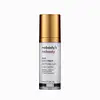What's inside
What's inside
 Key Ingredients
Key Ingredients

 Benefits
Benefits

 Concerns
Concerns

 Ingredients Side-by-side
Ingredients Side-by-side

Water
Skin ConditioningAloe Barbadensis Leaf Juice
Skin ConditioningCaprylic/Capric Triglyceride
MaskingDicaprylyl Carbonate
EmollientHyaluronic Acid
HumectantPropylene Glycol
HumectantGlycerin
HumectantXanthan Gum
EmulsifyingLecithin
EmollientC12-16 Alcohols
EmollientPalmitic Acid
EmollientCetearyl Alcohol
EmollientCetearyl Olivate
Sorbitan Olivate
EmulsifyingButyrospermum Parkii Butter
Skin ConditioningTheobroma Cacao Seed Butter
EmollientDimethicone
EmollientAllantoin
Skin ConditioningHexapeptide-8
Skin ConditioningBisabolol
MaskingTocopherol
AntioxidantCaviar Extract
Skin ConditioningPhenoxyethanol
PreservativeCaprylyl Glycol
EmollientParfum
MaskingLinalool
PerfumingWater, Aloe Barbadensis Leaf Juice, Caprylic/Capric Triglyceride, Dicaprylyl Carbonate, Hyaluronic Acid, Propylene Glycol, Glycerin, Xanthan Gum, Lecithin, C12-16 Alcohols, Palmitic Acid, Cetearyl Alcohol, Cetearyl Olivate, Sorbitan Olivate, Butyrospermum Parkii Butter, Theobroma Cacao Seed Butter, Dimethicone, Allantoin, Hexapeptide-8, Bisabolol, Tocopherol, Caviar Extract, Phenoxyethanol, Caprylyl Glycol, Parfum, Linalool
Water
Skin ConditioningCaprylic/Capric Triglyceride
MaskingCetearyl Alcohol
EmollientGlycerin
HumectantPrunus Amygdalus Dulcis Oil
Skin ConditioningCetyl Alcohol
EmollientMacadamia Ternifolia Seed Oil
EmollientSodium Acrylate/Sodium Acryloyldimethyl Taurate Copolymer
Emulsion StabilisingIsohexadecane
EmollientPolysorbate 80
EmulsifyingBeta-Glucan
Skin ConditioningCetearyl Glucoside
EmulsifyingPentylene Glycol
Skin ConditioningSodium Lactate
BufferingLactic Acid
BufferingSerine
MaskingUrea
BufferingSorbitol
HumectantSodium Chloride
MaskingAllantoin
Skin ConditioningRosa Moschata Seed Oil
EmollientAvena Sativa Kernel Meal
AbrasiveHydrolyzed Oat Flour
Skin ConditioningPhenoxyethanol
PreservativeCaprylyl Glycol
EmollientTriethanolamine
BufferingBenzyl Alcohol
PerfumingSorbic Acid
PreservativeAmmonium Acryloyldimethyltaurate/Vp Copolymer
Disodium EDTA
Tocopheryl Acetate
AntioxidantSorbitan Oleate
EmulsifyingWater, Caprylic/Capric Triglyceride, Cetearyl Alcohol, Glycerin, Prunus Amygdalus Dulcis Oil, Cetyl Alcohol, Macadamia Ternifolia Seed Oil, Sodium Acrylate/Sodium Acryloyldimethyl Taurate Copolymer, Isohexadecane, Polysorbate 80, Beta-Glucan, Cetearyl Glucoside, Pentylene Glycol, Sodium Lactate, Lactic Acid, Serine, Urea, Sorbitol, Sodium Chloride, Allantoin, Rosa Moschata Seed Oil, Avena Sativa Kernel Meal, Hydrolyzed Oat Flour, Phenoxyethanol, Caprylyl Glycol, Triethanolamine, Benzyl Alcohol, Sorbic Acid, Ammonium Acryloyldimethyltaurate/Vp Copolymer, Disodium EDTA, Tocopheryl Acetate, Sorbitan Oleate
Ingredients Explained
These ingredients are found in both products.
Ingredients higher up in an ingredient list are typically present in a larger amount.
Allantoin is a soothing ingredient known for its protective and moisturizingg properties. Because of this, it is often added to products with strong active ingredients.
Studies show higher concentrations of this ingredient can promote wound healing.
Though it can be derived from the comfrey plant, allantoin is produced synthetically for cosmetic products to ensure purity.
Learn more about AllantoinThis ingredient is an emollient, solvent, and texture enhancer. It is considered a skin-softener by helping the skin prevent moisture loss.
It helps thicken a product's formula and makes it easier to spread by dissolving clumping compounds.
Caprylic Triglyceride is made by combining glycerin with coconut oil, forming a clear liquid.
While there is an assumption Caprylic Triglyceride can clog pores due to it being derived from coconut oil, there is no research supporting this.
Learn more about Caprylic/Capric TriglycerideCaprylyl Glycol is a humectant and emollient, meaning it attracts and preserves moisture.
It is a common ingredient in many products, especially those designed to hydrate skin. The primary benefits are retaining moisture, skin softening, and promoting a healthy skin barrier.
Though Caprylyl Glycol is an alcohol derived from fatty acids, it is not the kind that can dry out skin.
This ingredient is also used as a preservative to extend the life of products. It has slight antimicrobial properties.
Learn more about Caprylyl GlycolCetearyl alcohol is a mixture of two fatty alcohols: cetyl alcohol and stearyl alcohol. It is mainly used as an emulsifier. Emulsifiers help prevent the separation of oils and products. Due to its composition, it can also be used to thicken a product or help create foam.
Cetearyl alcohol is an emollient. Emollients help soothe and hydrate the skin by trapping moisture.
Studies show Cetearyl alcohol is non-toxic and non-irritating. The FDA allows products labeled "alcohol-free" to have fatty alcohols.
This ingredient is usually derived from plant oils such as palm, vegetable, or coconut oils. There is debate on whether this ingredient will cause acne.
Due to the fatty acid base, this ingredient may not be Malassezia folliculitis safe.
Learn more about Cetearyl AlcoholGlycerin is already naturally found in your skin. It helps moisturize and protect your skin.
A study from 2016 found glycerin to be more effective as a humectant than AHAs and hyaluronic acid.
As a humectant, it helps the skin stay hydrated by pulling moisture to your skin. The low molecular weight of glycerin allows it to pull moisture into the deeper layers of your skin.
Hydrated skin improves your skin barrier; Your skin barrier helps protect against irritants and bacteria.
Glycerin has also been found to have antimicrobial and antiviral properties. Due to these properties, glycerin is often used in wound and burn treatments.
In cosmetics, glycerin is usually derived from plants such as soybean or palm. However, it can also be sourced from animals, such as tallow or animal fat.
This ingredient is organic, colorless, odorless, and non-toxic.
Glycerin is the name for this ingredient in American English. British English uses Glycerol/Glycerine.
Learn more about GlycerinPhenoxyethanol is a preservative that has germicide, antimicrobial, and aromatic properties. Studies show that phenoxyethanol can prevent microbial growth. By itself, it has a scent that is similar to that of a rose.
It's often used in formulations along with Caprylyl Glycol to preserve the shelf life of products.
Water. It's the most common cosmetic ingredient of all. You'll usually see it at the top of ingredient lists, meaning that it makes up the largest part of the product.
So why is it so popular? Water most often acts as a solvent - this means that it helps dissolve other ingredients into the formulation.
You'll also recognize water as that liquid we all need to stay alive. If you see this, drink a glass of water. Stay hydrated!
Learn more about Water